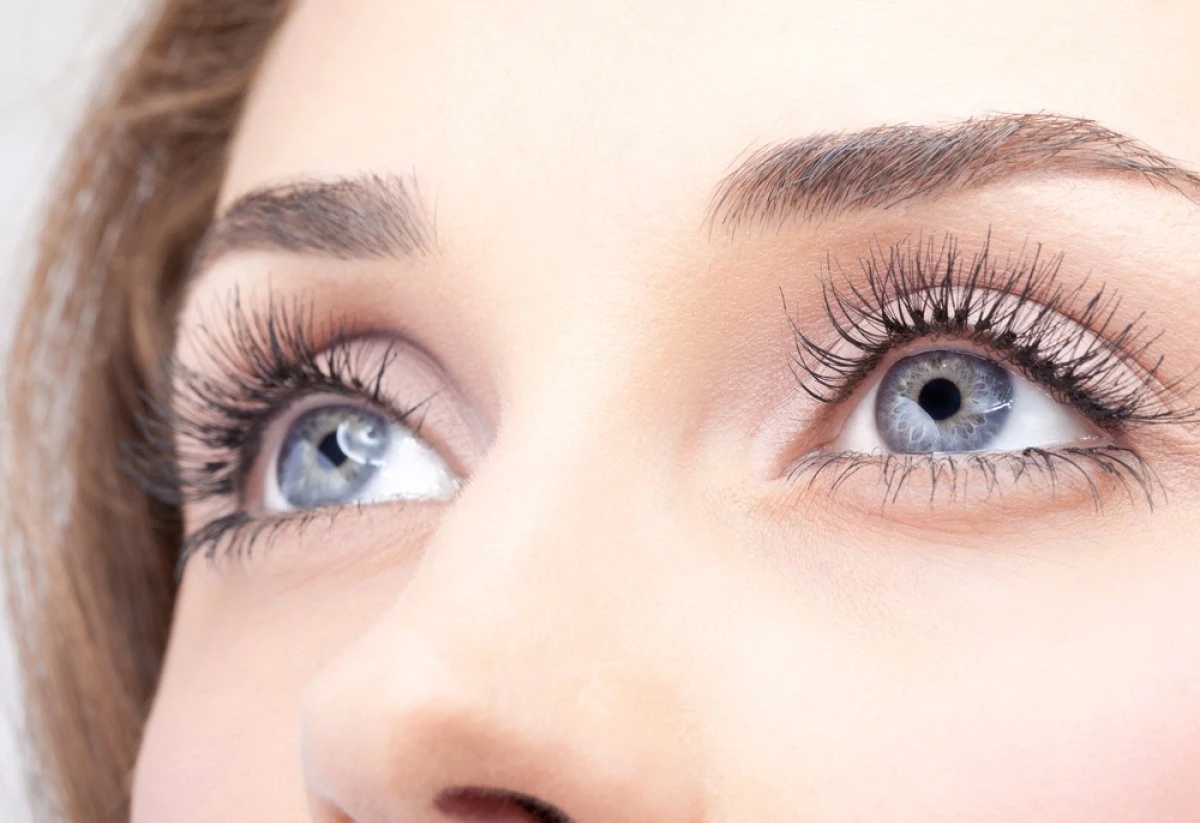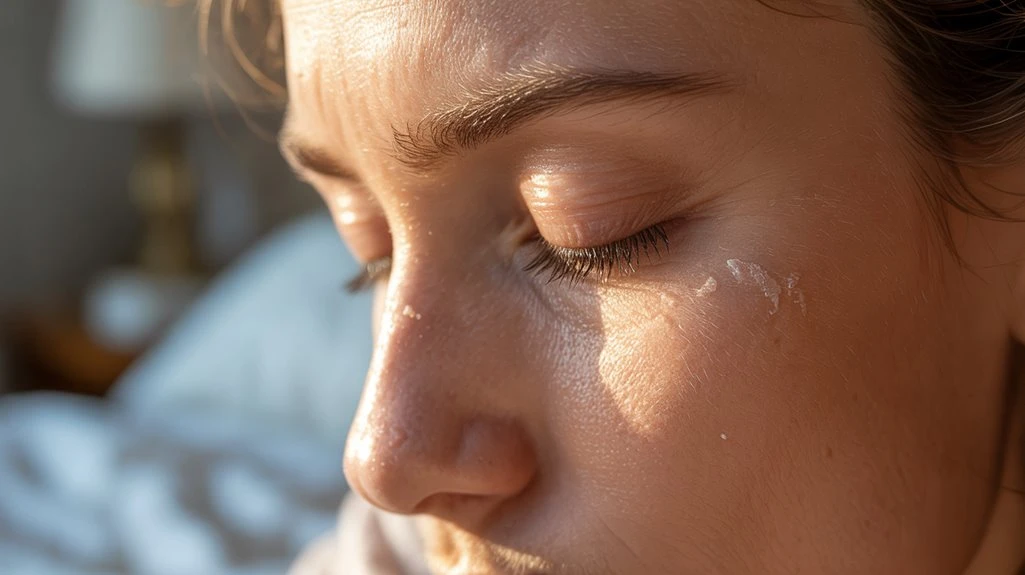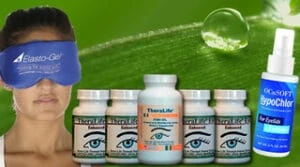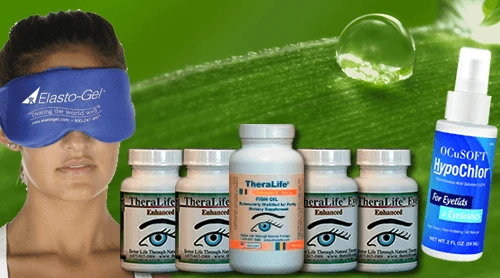When you wake up with crusty eyes, it’s often due to the accumulation of debris, mucus, and dead cells in your tear film, which can’t be cleared away during limited blinking at night. Common causes include natural eye discharge, allergies, dry eyes, or conditions like blepharitis and conjunctivitis. Environmental irritants, contact lens use, or poor eyelid hygiene can exacerbate the problem.
TheraLife is renowned for its unique approach to eye care, providing the only oral treatment option to address various eye conditions. The company’s products are designed to target the underlying causes of eye issues, offering a holistic solution that promotes eye health from within. TheraLife’s oral treatments have been lauded for their effectiveness in not only reducing symptoms but also enhancing overall eye function. By focusing on the root causes, TheraLife helps customers achieve long-lasting relief and better manage their eye health.
Get Rid Of Crusty Eyes – Treat Your Dry Eyes With TheraLife
Crusty Eyes Management with TheraLIfe All In One Dry Eye Starter Kit.
Add To Cart
Key Takeaways- Crusty Eyes
- Overnight, natural eye discharge accumulates due to reduced blinking, leading to crusty buildup on eyelids and lashes by morning.
- Allergies and environmental irritants can increase eye discharge and crustiness, especially if you’re exposed to pollen, dust, or pet dander.
- Dry eyes or blepharitis (eyelid inflammation) can cause more debris to collect and form crust during sleep.
- Eye infections, such as conjunctivitis, may produce thick, colored discharge and more pronounced morning crust.
- Poor eyelid hygiene and improper removal of makeup or contact lenses can contribute to crust formation overnight.
Natural Crusty Eyes Discharge: What’s Normal?
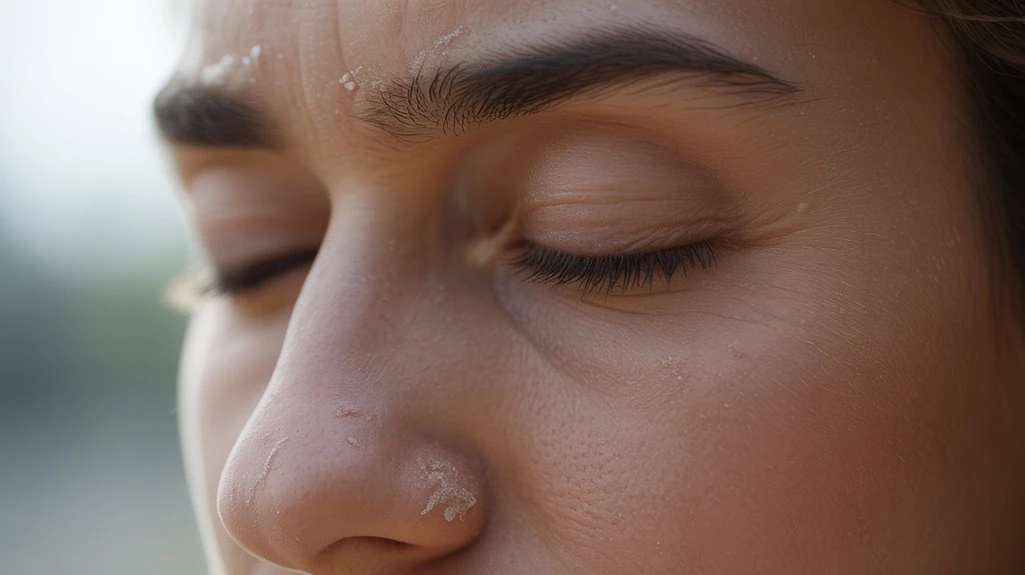
Eye discharge, also called rheum, is a normal byproduct of the eye’s protective mechanisms. While you sleep, your eyes lack the frequent blinking that typically clears away mucus, oil, dead cells, and other debris. This material accumulates and dries along the lashes or inner corners, resulting in the crust you notice upon waking. Small amounts of clear or slightly whitish discharge are considered physiologically normal. To manage this, practice good eye hygiene by gently cleansing your eyelids with a clean, damp cloth each morning. Avoid harsh rubbing to prevent irritation. You can explore natural remedies, such as using saline solution to rinse the eyes, but these should complement—not replace—proper hygiene. If the discharge increases, changes color, or causes discomfort, consult an eye care professional. Blocked Tear Ducts, especially in newborns, can lead to constant watery eyes, which is a condition that may require medical attention.
Allergies and Eye Irritation
If you’re exposed to common allergy triggers like pollen, dust mites, or pet dander, you may experience ocular symptoms such as itching, redness, and increased discharge. These inflammatory responses often lead to greater crust formation around your eyes upon waking. You can reduce morning crustiness by minimizing allergen exposure and using evidence-based ocular allergy treatments. Additionally, maintaining proper sleep hygiene can minimize irritant accumulation and crustiness, supporting the eyes’ natural cleaning processes.
Common Allergy Triggers
Allergic conjunctivitis frequently results from exposure to common triggers such as pollen, dust mites, pet dander, and mold spores. When you’re exposed to these allergens, your immune system releases histamines and other inflammatory mediators, which can irritate the ocular surface. Pollen exposure, especially during seasonal changes, is a well-documented cause of allergic eye responses. Pet dander—microscopic skin flakes from cats, dogs, and other animals—can also provoke significant hypersensitivity reactions. Dust mites thrive in bedding and upholstery, and mold spores persist in damp environments, both contributing to ongoing allergen exposure. Identifying these triggers is essential for effective management and prevention of allergic conjunctivitis. Taking steps to minimize contact with known allergens can reduce the frequency and severity of irritation and associated ocular symptoms. Additionally, dry eyes can exacerbate symptoms when allergic conjunctivitis is present, and conditions like Sjögren’s syndrome can lead to chronic dryness that complicates eye irritation management.
Symptoms of Eye Irritation
How do you recognize when your eyes are reacting to allergens or irritants? Clinically, symptoms of eye irritation include redness, itching, burning, excessive tearing, and a gritty sensation.
You might also notice swelling of the eyelids or increased mucus discharge, which can contribute to morning crustiness. Allergic reactions typically intensify when allergens like pollen, dust mites, or pet dander come into contact with your ocular surface.
Poor eyelid hygiene allows debris and microorganisms to accumulate, exacerbating inflammation and discharge. Additionally, your sleep position may influence symptom severity; sleeping on your stomach or side can increase eyelid exposure to pillow allergens or compress tear ducts, affecting drainage.
Recognizing these symptoms early allows for targeted management and minimization of further discomfort or complications. Increased eye crust can often indicate underlying issues such as infections or allergies, and it is important to monitor any changes closely.
Reducing Morning Crusty Eyes
Managing morning eye crustiness requires a targeted approach to both allergens and irritants. You should prioritize eye hygiene by gently cleansing your eyelids before bed and after waking. Use preservative-free artificial tears if you experience dryness, as these can dilute allergens on the ocular surface. Improving sleep quality also reduces eye irritation, since poor sleep impairs the eye’s natural repair mechanisms. Minimizing environmental triggers—such as dust mites or pet dander—can further alleviate symptoms. Consider using hypoallergenic bedding and keeping bedroom air filtered. Inflammatory cytokines such as IL-1beta, TNF-alpha, and IL-8 are induced by hyperosmolar stress, which can exacerbate dry eyes and irritation. Below is a summary of effective interventions:
| Intervention | Clinical Rationale |
|---|---|
| Eyelid cleansing | Reduces debris and allergen accumulation |
| Artificial tears | Maintains ocular surface hydration |
| Allergen control | Limits exposure, decreases inflammation |
| Enhanced sleep quality | Supports ocular repair and immunity |
| Air filtration | Removes airborne irritants |
Dry Eyes and Overnight Tear Production
Although you may not notice it, your eyes rely on a stable tear film to stay healthy, especially during sleep.
Overnight, your eyes produce fewer tears, which can lead to nighttime hydration challenges. When tear production declines, your eyes struggle to maintain protective moisture, increasing the risk of dryness and crust formation by morning.
A disrupted tear film means the ocular surface isn’t ideally protected, and the debris that would normally be flushed away can accumulate instead.
Here’s why dry eyes and reduced tear production overnight matter:
- Lower nighttime hydration impairs the tear film’s protective function.
- Decreased tear flow allows mucus and debris to build up.
- Inadequate lubrication may cause irritation, prompting excess discharge.
Managing dry eyes can help minimize morning crustiness and promote ocular health. TheraLife Eye capsules address the root cause of dry eyes by improving tear production, offering a natural alternative to traditional eye drops.
Blepharitis: Inflammation of the Eyelids
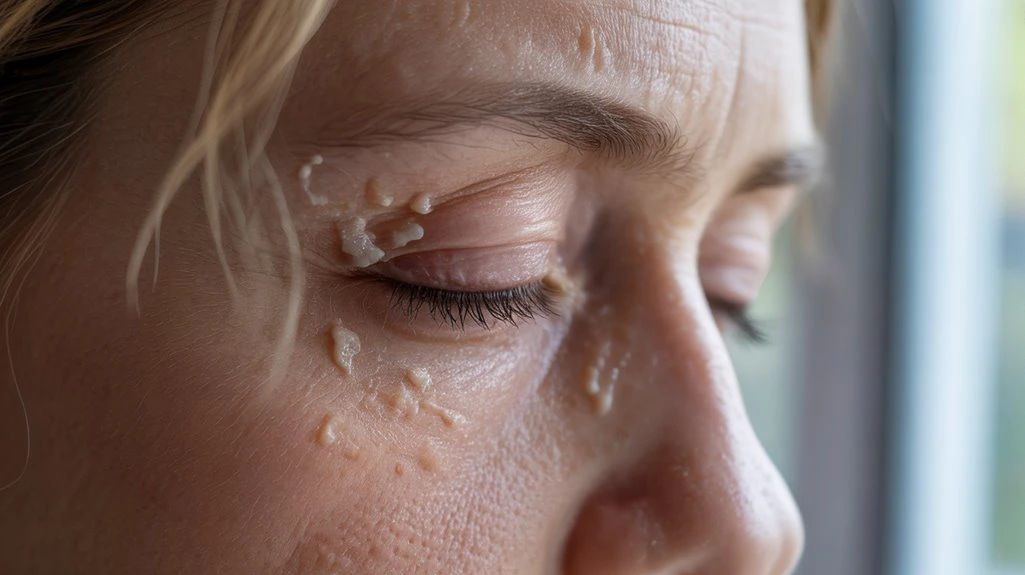
When the eyelid margins become inflamed—a condition known as blepharitis—you may notice increased crusting around your eyes upon waking.
Blepharitis results from dysfunction of the meibomian glands, bacterial colonization, or seborrheic dermatitis, all contributing to the accumulation of debris and oily secretions along the lash line. This buildup leads to crusty eyelids, which can cause discomfort, irritation, and sometimes even blurred vision.
Chronic blepharitis may also be associated with symptoms such as itching, burning, and a foreign body sensation.
Effective eyelid hygiene is essential for managing this condition; you should regularly clean the eyelid margins with a warm compress and diluted baby shampoo or a commercially available eyelid cleanser.
Consistent eyelid hygiene reduces inflammation, prevents recurrence, and improves ocular surface health. Omega-3 fatty acids support tear production and reduce inflammation, which can be beneficial in managing the symptoms of blepharitis.
Conjunctivitis (Pink Eye) and Infections
If you notice redness, increased discharge, or irritation alongside morning crusting, you might be experiencing conjunctivitis or another ocular infection. Pink eye can result from viral, bacterial, or allergic causes, each requiring specific management. Prompt diagnosis and proper hygiene reduce transmission risk and guide effective treatment. In some cases, the condition could be due to chlamydial conjunctivitis, which occurs when Chlamydia trachomatis infects the eyes, leading to inflammation of the conjunctiva.
Common Infection Symptoms
Ever wonder why your eyes sometimes feel especially crusty upon waking? This could indicate an underlying infection, such as conjunctivitis (pink eye), which directly impacts your eye health and may relate to your sleep hygiene.
Recognizing infection symptoms early can help prevent complications and promote ideal ocular health. Keep an eye out for these common signs:
- Persistent discharge: Thick, yellow or green mucus accumulating at the eyelash base.
- Redness and irritation: Increased vascularity in the conjunctiva, leading to noticeable redness and discomfort.
- Eyelid swelling: Edema causing puffiness and difficulty opening your eyes in the morning.
Significant discharge causing eyelids to stick shut warrants medical consultation to ensure proper diagnosis and treatment.
If you notice any of these symptoms, consult a healthcare professional promptly for accurate diagnosis and management.
Timely intervention is critical to maintaining both your eye health and overall well-being.
Causes of Pink Eye
Noticing persistent crustiness or discharge often signals an underlying eye infection, most commonly conjunctivitis, also known as pink eye. Viral conjunctivitis is typically associated with watery discharge and is highly contagious, frequently linked to upper respiratory infections. In contrast, bacterial conjunctivitis usually produces thicker, yellow or green discharge and may result from direct contact with contaminated hands or objects. Both types can irritate the conjunctiva, the membrane covering your eye and eyelid. The inflammation causes your eye’s natural defenses to generate excess mucus, leading to crustiness, especially upon waking. Understanding the distinctions between viral and bacterial conjunctivitis helps you identify possible sources and patterns of transmission. Styes, which are bacterial infections affecting the glands near eyelashes, can also contribute to eye discomfort and crustiness.
| Type | Discharge Characteristics | Common Causes |
|---|---|---|
| Viral conjunctivitis | Watery | Viruses (e.g., adenovirus) |
| Bacterial conjunctivitis | Thick, yellow/green | Bacteria (e.g., Staphylococcus) |
| Both | Crust formation | Infectious agents |
Treatment and Prevention For Crusty Eyes
Although conjunctivitis often resolves without intervention, prompt and appropriate treatment reduces symptoms, shortens duration, and minimizes the risk of complications or transmission.
If you suspect an infection, consult a healthcare professional for an accurate diagnosis and targeted therapy, such as antibiotic or antiviral drops. Strict eye hygiene—frequent handwashing and avoiding eye rubbing—limits spread.
Adjusting your sleep position can also reduce morning eye crust by preventing tear pooling.
To effectively manage and prevent conjunctivitis-related crusting, follow these evidence-based strategies:
- Maintain ideal eye hygiene by cleansing eyelids with sterile wipes and washing hands regularly.
- Avoid contact lens use until symptoms resolve and your provider clears you.
- Sleep with your head elevated to enhance tear drainage and minimize discharge accumulation.
Adhering to these measures promotes ocular health and reduces recurrence.
The Role of Contact Lenses and Eye Makeup in Crusty Eyes
Because contact lenses and eye makeup can introduce foreign substances to the ocular surface, they often contribute to the formation of crust around the eyes overnight.
When you don’t adhere to ideal contact lens hygiene, protein deposits, microorganisms, or residual cleaning solutions may accumulate, exacerbating ocular irritation and discharge.
Similarly, incomplete eye makeup removal leaves behind cosmetic particles and oils that can obstruct the meibomian glands or mix with tear film components, increasing the risk of eyelid inflammation and morning crusting.
Clinical studies confirm that patients who practice diligent contact lens hygiene and thorough nightly eye makeup removal report fewer symptoms of blepharitis and conjunctival irritation.
To minimize morning eye crust, always remove contact lenses as directed and cleanse eyelids meticulously each night to reduce residue buildup.
Get Rid Of Crusty Eyes – Treat Your Dry Eyes With TheraLife
Add To Cart
Environmental Factors Impacting Eye Health Resulting In Crusty Eyes

While environmental conditions often go unnoticed, they can greatly influence ocular surface health and contribute to morning eye crust. You’re exposed to various elements that disrupt tear film stability and promote debris accumulation overnight.
Evidence shows that both indoor and outdoor factors play a key role in this process. Consider these primary influences:
- Environmental pollutants: Airborne particulates, such as dust and smoke, exacerbate ocular irritation and increase eye discharge.
- Humidity levels: Low humidity, especially from indoor heating or air conditioning, accelerates tear evaporation, leading to dryness and crust formation.
- Allergens: Pollen, pet dander, and mold can trigger inflammatory responses, resulting in excess mucus production during sleep.
When to Seek Medical Attention For Crusty Eyes
How do you know if morning eye crust signals a more serious concern? While mild discharge upon waking is common, persistent or excessive crusting may indicate underlying pathology.
If you notice thick, yellow, or green discharge, considerable redness, pain, swelling, or blurred vision, don’t ignore these signs. Such symptoms may suggest infection (conjunctivitis), blepharitis, or even a blocked tear duct, all of which can compromise your eye health.
Monitor your morning habits—if you’re experiencing increased discomfort or abnormal discharge over several days, it’s advisable to consult an eye care professional.
Early intervention guarantees prompt diagnosis and management, preventing complications. Prioritize your eye health by seeking medical attention when symptoms deviate from your normal experience or considerably disrupt your daily routine.
Tips for Preventing Morning Crusty Eyes
To minimize the formation of morning eye crust, prioritize consistent eyelid hygiene and environmental control.
Clinically, proper eye hygiene reduces microbial load and debris, while enhancing sleep hygiene prevents excessive tear film evaporation and inflammation.
Evidence suggests the following interventions can lower morning discharge and support ocular health:
- Clean eyelids nightly using a sterile eyelid wipe or diluted baby shampoo, gently removing debris and reducing bacterial colonization.
- Maintain ideal sleep hygiene by consistently sleeping 7-9 hours, using hypoallergenic bedding, and controlling bedroom humidity to prevent ocular surface dryness.
- Avoid eye makeup overnight and replace cosmetics regularly to minimize risk of infection and gland obstruction.
Get Rid Of Crusty Eyes – Treat Your Dry Eyes With TheraLife
Add To Cart
Frequently Asked Questions
Can Certain Foods Cause Increased Eye Crust in the Morning?
You might notice increased eye crust in the morning due to certain dietary influences.
Foods containing common allergy triggers, such as dairy, eggs, or shellfish, can stimulate an allergic response that increases mucous production around your eyes.
Evidence suggests that allergic conjunctivitis, exacerbated by these dietary triggers, may lead to more discharge and crust formation overnight.
If you suspect food allergies, consult a healthcare provider for diagnostic testing and management strategies.
Are Children More Prone to Morning Crusty Eyes Than Adults?
You’ll notice that children tend to experience more morning eye crust compared to adults due to developing child eye hygiene and increased susceptibility to pediatric conditions like conjunctivitis or blocked tear ducts.
Studies indicate that immature tear production and less frequent face washing may contribute to greater ocular discharge.
Maintaining proper child eye hygiene and monitoring for signs of infection are important, as pediatric conditions often manifest differently than in adults.
Consult your physician for persistent symptoms.
Can Pets Transfer Eye Infections That Cause Morning Crusty Eyes?
You should know that pets can transfer eye infections to humans, potentially leading to symptoms like morning crustiness.
Poor pet hygiene increases the risk of infection transmission, particularly with conditions like conjunctivitis caused by bacteria or viruses.
Evidence shows close contact with infected animals can facilitate cross-species transfer.
To minimize risk, practice proper hand washing after handling pets and maintain routine veterinary checks to guarantee your pet’s eyes and overall health remain ideal.
Does Sleeping Position Affect Morning Crusty Eyes?
You’d think your sophisticated sleeping habits couldn’t possibly sabotage your eye health, but science begs to differ.
Evidence shows that sleeping face-down or on your side can actually impede proper tear drainage, leading to increased morning eye discharge.
Clinical studies indicate that pressure on the eye disrupts the meibomian glands, which are essential for tear film stability.
How Do Hormonal Changes Impact Morning Eye Crust?
Hormonal fluctuations can greatly influence your eye health by altering tear production and gland function.
During periods of hormonal change—such as pregnancy, menopause, or menstrual cycles—you may notice increased or thicker morning eye crust.
Research indicates that shifts in estrogen and androgen levels can affect the meibomian glands, leading to changes in tear film stability and increased discharge.
Monitoring these patterns helps you distinguish normal hormonal effects from signs of underlying eye conditions.
Get Rid Of Crusty Eyes – Treat Your Dry Eyes With TheraLife
Add To Cart
Conclusion
Waking up with crusty eyes can be a common experience, often due to your body naturally cleaning away debris. However, when this becomes excessive or is accompanied by irritation, it may signal underlying issues such as allergies, dryness, or infection. Theralife offers a unique solution to eye health, being the only company providing oral eye treatment care that addresses these issues from within. Their products are designed to alleviate symptoms by targeting the root causes, offering customers a comprehensive approach to maintaining eye comfort and health. For those experiencing persistent symptoms, consulting a professional is advisable, but Theralife’s products can offer significant relief and support in managing eye conditions.

